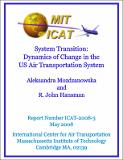| dc.description.abstract | The US Air Transportation System is currently facing a number of challenges including an
increasing demand for travel and growing environmental requirements. In order to successfully
meet future needs, the system will need to transition from its current state using a combination
of technology, infrastructure, procedure, and policy changes. However, the complexities
of the air transportation system make implementing changes a challenge. In particular, the
multi-stakeholder nature of the system poses a significant barrier to transition.
Historically, many changes in the air transportation system were driven by safety concerns
and implemented following accidents which provided the momentum to overcome transition
barriers. As a result of past changes, the system has become increasingly safe resulting
in the emergence of new drivers for change. Security has emerged as a driver following
the terrorist attacks of 9/11/2001 in the US and a number of system changes have since
been implemented. Currently, capacity is one of the largest drivers of change. Addressing
capacity issues requires solutions that can be accepted by stakeholders, and pass the necessary
certification and approval requirements for implementation. The contribution of aviation
to global greenhouse gas emissions is also becoming a significant driver for change in the
system. The goal of this work is to understand how the air transportation system changes in
response to safety, security, capacity, and environmental drivers for transition.
In order to understand the dynamics of transition, historical cases of system change were
studied. Twenty seven such cases have been analyzed to construct a feedback process model
of transition and to explore specific change dynamics observed. These dynamics include:
understanding the role of crisis events as catalyst for change; the effect that timing of solution
development has on the overall time constant for change; the role that stakeholder objectives
play in the transition process, and the use of approval and certification processes to stall or
block change.
Understanding the process of change in the US Air Transportation System can inform future
changes in aviation as well as in other systems with similar properties. | en |
